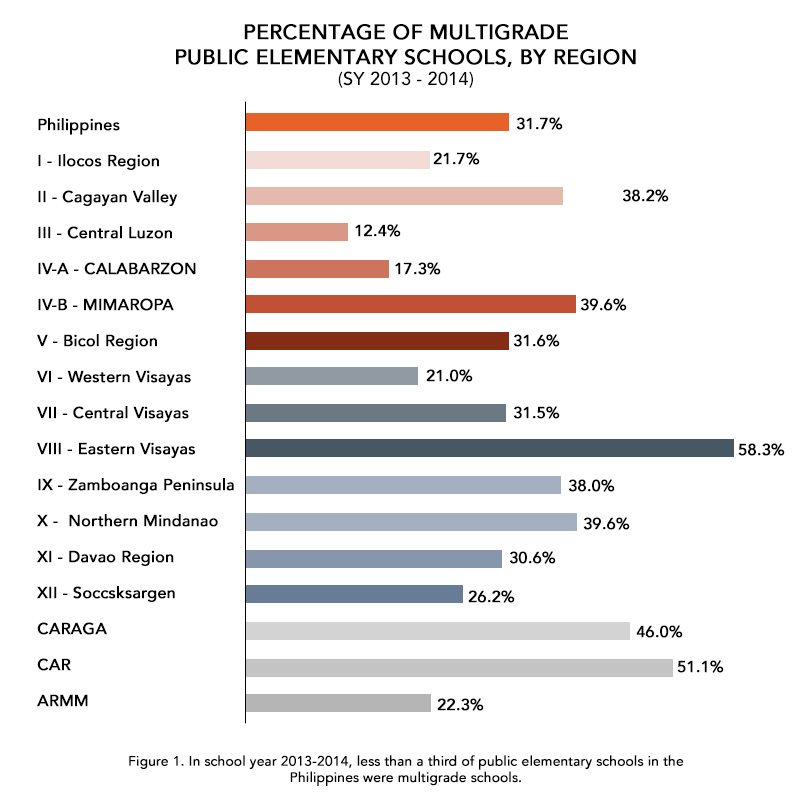SUMMARY
This is AI generated summarization, which may have errors. For context, always refer to the full article.

Public elementary schools in many remote areas have few students because they are in communities with only a small number of families. Oftentimes, these schools combine pupils of different grade levels in a single classroom with only one teacher supervising them the entire school year. These are called multigrade programs.
Formally implemented in the 1990s by the Department of Education (DepEd), the multigrade design aimed to widen and improve access to elementary education, particularly among children in poor, disadvantaged, and geographically isolated areas.
Based on data from DepEd, 31.7% or 12,278 of the 38,683 public elementary schools have multigrade classes (school year 2013-2014).
Eastern Visayas Region has the highest concentration of multigrade schools, totaling 58.3% of total public elementary schools (Figure 1). Central Luzon, a region with highly urbanized areas, has the lowest (12.4%).
Of the 15 million public elementary students in 2013, 9.5% or 1.4 million were enrolled in multigrade schools.

In 2013, 18.7% of the multigrade schools (or 2,299 schools) are multigrade-only schools, while the rest (9,979 schools) had combined multigrade and monograde classes. Since many multigrade-only schools are in rural remote communities, many do not offer all grades of elementary school. Over half (52%) of these do not offer a complete cycle.
Young children in remote areas may have a school nearby that offers classes of only up to 3rd or 4th grade, and if they want to complete the cycle of elementary school they have to move to a complete school farther away from their town. Children in these kinds of schools have a high risk of not completing their education because of the restrictive cost of attending faraway schools.
Learning environments in multigrade classrooms are not necessarily poorer. There are systems of education (like the Montessori system) that recommend mixing children of different ages in the belief that this set-up helps them learn.
Scores from the 2014 National Achievement Test (NAT) suggest that multigrade schools can be beneficial in the lower grades or, at the very least, they perform equally well.
However, when children are in the higher grades, the multigrade learning environment appears to yield lower scores.
Multigrade schools performed slightly better than monograde schools in Grade 3 NAT but they performed worse than monograde schools in Grade 6 NAT.
In the 2014 NAT for Grade 3, multigrade schools scored an overall average mean per student (MPS) of 64.05 (out of 100) which is slightly higher than monograde schools’ 62 (Figure 2).
In the Grade 6 NAT, however, multigrade schools performed significantly worse than monograde schools in all the 5 subject tests (i.e., mathematics, science, English, Filipino, social studies). Overall, multigrade schools scored an average of 71.75, lower than monograde schools’ average of 75.05.

Complete multigrade-only schools performed the best among all school types in Grade 3 NAT but performed the worst in Grade 6 NAT.
In the 2014 test for Grade 3, schools that only had multigrade classes (complete schools) from grades 1 to 6, scored the highest in all subjects across all the school types. Complete multigrade-only schools scored an average MPS of 65.47, higher than the average score of multigrade-only schools (64.43), incomplete multigrade-only schools (62.76), all multigrade schools (64.05), and monograde schools (62.94).
In the Grade 6 NAT, however, multigrade-only schools (at this point, all these schools are classified as complete) performed the poorest among all school types. Overall, the average MPS of multigrade-only schools is 69.94, which is lower than the average of all multigrade schools (71.75) and, monograde schools (75.05).
Addressing performance gaps
In the early years of schooling, students in multigrade schools – especially those in complete multigrade-only schools – perform at the same level or better than those in monograde schools. This advantage, however, diminishes as students reach the last years of elementary education.
By the time students reach their final year in grade school, the performance gap between monograde and multigrade schools has reversed and has become wider – with monograde schools outscoring their multigrade counterparts.
While monograde schools’ Grade 6 overall score was better than their Grade 3 score by an average of 12.11 points, multigrade schools’ Grade 6 score was only higher than their Grade 3 score by 7.67 points and for multigrade-only schools, only 5.51 points.
The system of multigrade schooling is important to universal access to education, and it should be maintained even with current shortfalls performance when children get older.
The challenge is to narrow the performance gap in later years of elementary, something that can be addressed by special teacher training or maintaining smaller class sizes, or better yet, whenever possible, reverting to monograde classes in the later grades.
Test scores provide only a limited picture of the performance of multigrade schools. In order to devise more specific interventions to improve student learning, in-depth field research must be undertaken to inform the design and rollout of programs. – Rappler.com
Note:
This analysis was supported by a research grant from the UP EIDR Grant C06-013. The authors thank DepEd for providing the data. The analyses contained and views expressed are of the authors alone and do not reflect the views of DepEd or UP.
Jenna Mae Atun is a Lecturer at the Department of Communication at the Ateneo de Manila University where she teaches communication research. She is also pursuing a masters in Development Economics at the UP School of Economics. Clarissa C. David is a Professor at the UP College of Mass Communication and a fellow of Social Weather Stations Inc. She is also the 2015 Outstanding Young Scientist awardee for social science by the National Academy of Science and Technology (NAST).
Add a comment
How does this make you feel?
There are no comments yet. Add your comment to start the conversation.